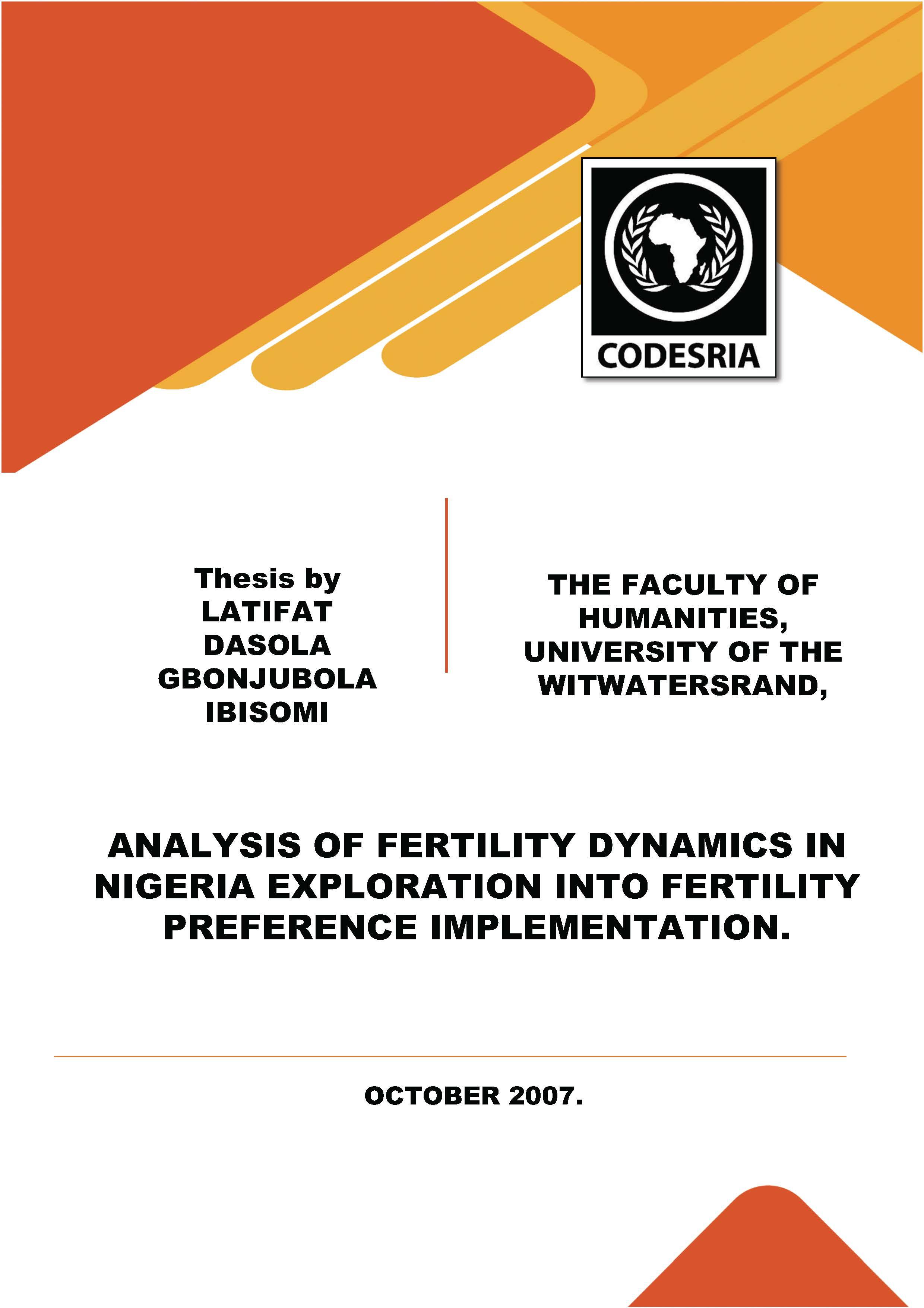Analysis of Fertility Dynamics in Nigeria: Exploration into Fertility Preference Implementation
Keywords:
Fertility, fertility determinants, family planning, fertility rate, NigeriaSynopsis
While studies have indicated the onset of fertility transition in Nigeria as in most SubSaharan countries, no systematic attempt has been made to identify the factors responsible for this trend. Existing explanation tends to draw from the demographic transition theory without exploring the value of other key variables. One of these variables is the degree of preference implementation. This study explores the role of fertility preference implementation on the onset of fertility transition in Nigeria. The study estimated the extent to which couples have been able to implement their fertility preferences with a view to better understand the factors that are responsible for the fertility changes in the country. This study was based on the socio-economic and microeconomic frameworks of fertility namely: the Bongaarts et al (1984) version and its Stover's reformulation (1998) of the proximate determinants of fertility and the Bongaarts (1993) supplydemand framework for the analysis of the determinants of fertility, respectively. The proximate determinant of fertility frameworks holds that all demographic, socioeconomic,
cultural, institutional, psychological, health and environmental factors (background variables) operate through the proximate or intermediate variables to affect fertility. The Bongaarts (1993) supply-demand framework posits that fertility (F) as measured by total fertility rate is an outcome of the interaction of supply of births (natural fertility), demand for births (wanted fertility) and degree of fertility preference implementation (an index, which measures the extent to which people have been able to implement their fertility preferences). The degree of preference implementation is in turn dependent on cost of fertility regulation and that of unwanted childbearing. The husbands' family planning attitude and desired number of children were incorporated into the latter framework to recognize and bring out the crucial roles of the males in eventual fertility outcomes. The 1990, 1999 and 2003 Nigeria Demographic and Health Survey (NDHS) data sets for men, women and couples were used. The methodology of the three NDHS is not too different from each other. They are nationally representative cross-sectional survey of women between the ages of 15 and 49 in 1990, 1999 and 2003 and men between 15 and 64 in 1999 and 15-59 in the 2003 survey. Twenty-four focus group discussions were also conducted among the sexes across the country to gain better insight and understanding into the issues examined. Focus group research is based on · facilitating an organized discussion with a group of individuals selected because the were believed to be representative of some class. The discussion is used to bring out insights and understandings in ways, which cannot be captured by questionnaire. The focus group discussions (FGD) are also national in scope. Participants were drawn from the Northern, South Eastern and South Western regions of the country. The study population consisted of 8,781; 8,199 and 7,620 women aged 15-49 interviewed during the 1990, 1999 and 2003 NDHS, respectively. In addition, 2,584 men aged 15-64 and 2,346 men aged 15-59 interviewed during the 1999 and 2003 NDHS, respectively were used. One thousand, one hundred and sixty-eight (1,168) couples' records derived from the 2003 NDHS and 1,280 (constructed) couples' records for 1999 were also used. A total of eighty-nine (89) men and eighty-five (85)
women participated in the twenty-four (24) focus group discussion sessions.
Downloads
References
Adeboyejo AT and Onyeonoru IP. 2003. Residential Density and Adolescent Reproductive Health Problems in Ibadan, Nigeria. African Population Studies, Volume 18, Number 1: 81-95
Adegbola 0. 1987. Regional and Socio-economic Fertility Differentials in Nigeria, 1981- 82. Interuniversity Programme in Demography (IPD) Working Paper 1987-6.
African Population and Health Research Center (APHRC). 2002. Population and Health Dynamics in Nairobi's Informal Settlements.
Akinkunmi JO. 1989. On the Dynamics of the Proximate Determinants of Fertility in Nigeria: Their Demographic Consequences and Policy Implications. Unpublished PhD Dissertation, Legon: RIPS, University of Ghana.
Answers.corn. 2007. Infertility. www.answers.com/topic/infertility Accessed 2007/02/27. Arriaga EE 1994. Population Analysis with Microcomputers: presentation of Techniques. Volume 1.
Ayiemba. EHO. 1983. Nuptial Determinants of Fertility in Western Kenya. A thesis submitted in fulfillinent for the degree of Doctor of Philosophy in the University of Nairobi. July 1983.
Bagozzi RP and Van Loo MF. 1978. Toward a General Theory of Fertility: A Causal Modeling Approach. Demography, Volume 15, Number 3: 301-320.
Bankole A and Olaleye DO. 1993. Do Marital Partners have different Reproductive Preferences in Sub-Saharan Africa? Paper presented at the International Union for the Scientific Study of Population seminar on women and demographic change in Sub-Saharan Africa, Dakar, Senegal.
Bankole A and Singh S. 1998. Couples' fertility and Contraceptive Decision-Making in Developing Countries: Hearing the man's Voice. International Family Planning Perspectives, Volume 24, Number 1:15-24.
Bankole A and Westoff CF. 1995. Childbearing Attitudes and Intentions. DHS Comparative Reports Number 17. ORC Macro Calverton, Maryland USA.
Bankole A. 1995. Desired Fertility and Fertility Behaviour Among the Yoruba of Nigeria: A Study of Couple Preferences and Subsequent Fertility. Population Studies, Volume 49, Number 2: 317-328.






